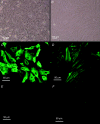Regulation of smooth muscle contractility by the epithelium in rat vas deferens: role of ATP-induced release of PGE2
- PMID: 18755753
- PMCID: PMC2614070
- DOI: 10.1113/jphysiol.2008.154096
Regulation of smooth muscle contractility by the epithelium in rat vas deferens: role of ATP-induced release of PGE2
Abstract
Recent studies suggest that the epithelium might modulate the contractility of smooth muscle. However, the mechanisms underlying this regulation are unknown. The present study investigated the regulation of smooth muscle contraction by the epithelium in rat vas deferens and the possible factor(s) involved. Exogenously applied ATP inhibited electrical field stimulation (EFS)-evoked smooth muscle contraction in an epithelium-dependent manner. As the effects of ATP on smooth muscle contractility were abrogated by inhibitors of prostaglandin synthesis, but not by those of nitric oxide synthesis, prostaglandins might mediate the effects of ATP. Consistent with this idea, PGE(2) inhibited EFS-evoked smooth muscle contraction independent of the epithelium, while ATP and UTP induced the release of PGE(2) from cultured rat vas deferens epithelial cells, but not smooth muscle cells. The ATP-induced PGE(2) release from vas deferens epithelial cells was abolished by U73122, an inhibitor of phospholipase C (PLC) and BAPTA AM, a Ca(2+) chelator. ATP also transiently increased [Ca(2+)](i) in vas deferens epithelial cells. This effect of ATP on [Ca(2+)](i) was independent of extracellular Ca(2+), but abolished by the P2 receptor antagonist RB2 and U73122. In membrane potential measurements using a voltage-sensitive dye, PGE(2), but not ATP, hyperpolarized vas deferens smooth muscle cells and this effect of PGE(2) was blocked by MDL12330A, an adenylate cyclase inhibitor, and the chromanol 293B, a blocker of cAMP-dependent K(+) channels. Taken together, our results suggest that ATP inhibition of vas deferens smooth muscle contraction is epithelium dependent. The data also suggest that ATP activates P2Y receptor-coupled Ca(2+) mobilization leading to the release of PGE(2) from epithelial cells, which in turn activates cAMP-dependent K(+) channels in smooth muscle cells leading to the hyperpolarization of membrane voltage and the inhibition of vas deferens contraction. Thus, the present findings suggest a novel regulatory mechanism by which the epithelium regulates the contractility of smooth muscle.
Figures











Comment in
-
Purinergic agonists flex vas deferens muscle.J Physiol. 2008 Nov 15;586(22):5287. doi: 10.1113/jphysiol.2008.164350. J Physiol. 2008. PMID: 19011131 Free PMC article. No abstract available.
Similar articles
-
A comparison of the effects of exogenous and endogenous prostaglandins on fast and slow contractions of field-stimulated guinea-pig vas deferens.Br J Pharmacol. 1995 Nov;116(6):2679-84. doi: 10.1111/j.1476-5381.1995.tb17226.x. Br J Pharmacol. 1995. PMID: 8590989 Free PMC article.
-
A contraction-mediating receptor for UTP, presumably P2Y2, in rat vas deferens.Naunyn Schmiedebergs Arch Pharmacol. 1999 Aug;360(2):196-201. doi: 10.1007/s002109900049. Naunyn Schmiedebergs Arch Pharmacol. 1999. PMID: 10494890
-
Cellular mechanism underlying the facilitation of contractile response of vas deferens smooth muscle by sodium orthovanadate.Mol Cell Biochem. 2012 Jul;366(1-2):149-57. doi: 10.1007/s11010-012-1292-0. Epub 2012 Apr 4. Mol Cell Biochem. 2012. PMID: 22476902
-
T-type Ca2+ channels and the urinary and male genital tracts.Pflugers Arch. 2014 Apr;466(4):781-9. doi: 10.1007/s00424-014-1446-x. Epub 2014 Jan 25. Pflugers Arch. 2014. PMID: 24463704 Review.
-
Calcium signaling in smooth muscle.Cold Spring Harb Perspect Biol. 2011 Sep 1;3(9):a004549. doi: 10.1101/cshperspect.a004549. Cold Spring Harb Perspect Biol. 2011. PMID: 21709182 Free PMC article. Review.
Cited by
-
Role of Epithelium Sodium Channel in Bone Formation.Chin Med J (Engl). 2016 Mar 5;129(5):594-600. doi: 10.4103/0366-6999.176994. Chin Med J (Engl). 2016. PMID: 26904995 Free PMC article. Review.
-
ATP secretion in the male reproductive tract: essential role of CFTR.J Physiol. 2012 Sep 1;590(17):4209-22. doi: 10.1113/jphysiol.2012.230581. Epub 2012 Jun 18. J Physiol. 2012. PMID: 22711960 Free PMC article.
-
Infection by Toxoplasma gondii, a severe parasite in neonates and AIDS patients, causes impaired anion secretion in airway epithelia.Proc Natl Acad Sci U S A. 2015 Apr 7;112(14):4435-40. doi: 10.1073/pnas.1503474112. Epub 2015 Mar 23. Proc Natl Acad Sci U S A. 2015. PMID: 25831498 Free PMC article.
-
Aerobic exercises regulate the epididymal anion homeostasis of high-fat diet-induced obese rats through TRPA1-mediated Cl- and HCO3- secretion†.Biol Reprod. 2023 Jul 11;109(1):53-64. doi: 10.1093/biolre/ioad050. Biol Reprod. 2023. PMID: 37154585 Free PMC article.
-
Enhanced uridine adenosine tetraphosphate-induced contraction in renal artery from type 2 diabetic Goto-Kakizaki rats due to activated cyclooxygenase/thromboxane receptor axis.Pflugers Arch. 2014 Feb;466(2):331-42. doi: 10.1007/s00424-013-1330-0. Epub 2013 Jul 31. Pflugers Arch. 2014. PMID: 23900807
References
-
- Aitken RJ, Kelly RW. Analysis of the direct effects of prostaglandins on human sperm function. J Reprod Fertil. 1985;73:139–146. - PubMed
-
- Balzary RW, Cocks TM. Lipopolysaccharide induces epithelium- and prostaglandin E2-dependent relaxation of mouse isolated trachea through activation of cyclooxygenase (COX)-1 and COX-2. J Pharmacol Exp Ther. 2006;317:806–812. - PubMed
-
- Bos CL, Richel DJ, Ritsema T, Peppelenbosch MP, Versteeg HH. Prostanoids and prostanoid receptors in signal transduction. Int J Biochem Cell Biol. 2004;36:1187–1205. - PubMed
-
- Brauner T, Hulser DF, Strasser RJ. Comparative measurements of membrane potentials with microelectrodes and voltage-sensitive dyes. Biochim Biophys Acta. 1984;771:208–216. - PubMed
Publication types
MeSH terms
Substances
LinkOut - more resources
Full Text Sources
Research Materials
Miscellaneous

